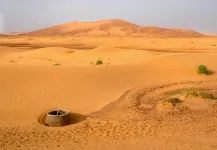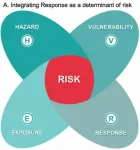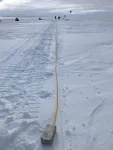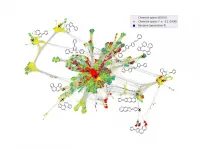(Press-News.org) "Jack and Jill went up the hill to fetch a pail of water." It's a silly rhyme, but one that highlights a simple fact: Humans have long relied on wells -- such as the one on the hill visited by Jack and Jill -- for their primary drinking water supply.
Although the number of people who draw their water by pail is declining as pumps become ever more widespread, groundwater wells still supply drinking water to more than half of the world's population and sustain over 40% of irrigated agriculture. But this vital resource underfoot often gets overlooked.
UC Santa Barbara assistant professors Debra Perrone and Scott Jasechko have compiled the most comprehensive assay of groundwater wells to date, spanning 40 countries that collectively account for half of all global groundwater pumping. Their study, the cover story of the April 23 edition of the journal Science, offers an unprecedented account of the world's groundwater resources.
"We analyzed construction records for tens of millions of groundwater wells around the world," said Jasechko, of the university's Bren School of Environmental Science & Management, "and the big take home is that many wells are at risk of running dry." Up to one in five wells in their survey, to be exact.
"These groundwater wells are used to withdraw water for household use or irrigation," added Perrone, a faculty member in the Environmental Studies Program. "Our study is the first time that groundwater wells and water level observations have been stitched together like this, providing local insights at the global scale."
Reaching these conclusions required the better part of six years' work by Perrone and Jasechko. The researchers culled their data from more than 100 unique databases around the world, sometimes in different formats and languages.
The first step involved compiling roughly 39 million records of functional groundwater wells that included depth, purpose, location and construction date. Rather than delegate processing the data to an algorithm or AI, the researchers carefully went through tidying it up manually. "We wanted to be sure we understood the limitations and nuances for each database we analyzed," Jasechko said.
With the data sorted, the authors compared the depths of local water tables against well depths. They found that 6 to 20% of the wells in their global sample were at risk of running dry if water levels continue to decline by just a few meters. They sought to find trends in the depths of new wells compared to existing wells in a given area from 1950 through 2015. While newer wells tended to be deeper than older ones, the trend was not ubiquitous, they said. Functional wells were not getting substantially deeper in many of the areas they surveyed.
The researchers then pulled data from roughly 1.1 million monitoring wells, which provide measurements of groundwater levels and conditions. These records supplied not only an account of where the water table lay, but also how much it fluctuated over the course of the year. Seasonal variation, they found, was typically within one meter.
By comparing depth trends to measurements from nearby monitoring wells, Perrone and Jasechko could also deduce how close functional wells were to drying out. They found that in many areas groundwater levels are declining, yet new wells are not being drilled deeper to keep pace with the falling water table. Since wells aren't getting substantially deeper in many areas, newer wells are at least as vulnerable as older wells should groundwater levels continue to decline.
"In some places, groundwater levels are close to the bottom of wells," Perrone stated. "If groundwater levels continue to decline in these places, wells will go dry, leaving people without access to water."
The two researchers also availed themselves of data from NASA's GRACE mission. The pair of GRACE satellites detect small differences in the Earth's gravitational field as they orbit the planet. This provided Perrone and Jasechko with information about groundwater reserves for regions where data from monitoring wells is limited.
"We only have groundwater level monitoring data for a few dozen countries," Jasechko said, "but GRACE data allows us to explore changes in water storage around the globe." While the resolution was coarse, the additional information confirmed the disconnect between declining groundwater and the construction of deeper wells.
There are many reasons not to drill deeper. It's much more expensive in terms of drilling and operational costs. The quality of groundwater can also decrease at depth, often becoming more saline toward the bottom of an aquifer.
"Drilling wells is expensive," Jasechko remarked. "Even if fresh water exists deep underground, not every individual or household has the capital to drill a new well to access it, which raises concerns about equity when wells run dry."
The pair hope to expand the coverage of their dataset, especially to countries like China, Iran and Pakistan, three major users of groundwater that the researchers could not obtain records from. They also plan to investigate the extent of groundwater decline in future research, looking for information on how quickly water tables are dropping and where the trend is accelerating.
Groundwater can provide a lifeline in even the most arid regions.
Perrone and Jasechko have made a name for themselves in the field of groundwater research by approaching the topic with enormous datasets like this one. The global study comes on the heels of another paper published in Nature on groundwater resources across the United States. There, they revealed the extent to which rivers across the country are losing flow to aquifers, in part due to pumping.
Together, the findings paint a broad picture not just of wells in danger, but of dwindling groundwater resources as a whole. While pumping may have the most direct impact on aquifers, the authors note, human activity has many indirect effects on groundwater quality and levels. Industrial activity, water diversion and even pavement and runoff affect the water beneath our feet. Climate change may exert the greatest influence over the long term, as it alters the distribution and intensity of precipitation and evapotranspiration from plants and soils worldwide.
"These findings highlight the importance of groundwater resources and groundwater management to the global community," Perrone said. "Putting all the data together reveals that declining groundwater levels threaten wells in many places across the world."
Groundwater sustainability is a complex issue with a lot of considerations and tradeoffs, the authors acknowledged. Deciding on a course of action won't be easy, but compiling and analyzing large datasets like this are a critical first-step in tackling the challenge. "With these data, we can make more informed management decisions to help us use groundwater sustainably," Perrone said.
INFORMATION:
A team of researchers from the Africa Climate and Development Initiative (ACDI) led a global team of 21 climate risk scholars to better understand and inform decision making around climate change risks in Africa and globally by examining how the drivers of risk interact.
Their work extends on existing risk frameworks with the hope that this research could help decision makers, managers and researchers understand the inherent complexity of climate change.
"Understanding the interactions among risks holds potential to change the way we respond to the risks. This is important because policy makers may worry about the risk of implementing a response as much, or more so, than the risk ...
A Southern California high school junior has built a low-cost seismometer device that delivers earthquake early warnings for homes and businesses. Costing less than $100 for her to make today, the seismometer could someday be a regular household safety device akin to a smart smoke detector, says its inventor Vivien He.
About the size of a Rubik's cube and encased in clear acrylic, the seismometer has a sleek, consumer-ready look. The device's geophone detects incoming ground motion, while onboard hardware and software translate the geophone's electrical signals into a digital waveform. The device has detected all earthquakes over magnitude 3.0 around Los Angeles since September 2020.
When ...
At the Seismological Society of America's 2021 Annual Meeting, researchers shared how they are using fiber optic cable to detect the small earthquakes that occur in ice in Antarctica.
The results could be used to better understand the movement and deformation of the ice under changing climate conditions, as well as improve future monitoring of carbon capture and storage projects, said Anna Stork, a geophysicist at Silixa Ltd.
Stork discussed how she and her colleagues are refining their methods of distributed acoustic sensing, or DAS, for microseismicity--earthquakes too small to be felt. DAS works by using the tiny internal flaws within an optical fiber as thousands of seismic ...
A deep spatiotemporal neural network trained on more than 36,000 earthquakes offers a new way of quickly predicting ground shaking intensity once an earthquake is underway, researchers report at the Seismological Society of America (SSA)'s 2021 Annual Meeting.
DeepShake analyzes seismic signals in real time and issues advanced warning of strong shaking based on the characteristics of the earliest detected waves from an earthquake.
DeepShake was developed by Daniel J. Wu, Avoy Datta, Weiqiang Zhu and William Ellsworth at Stanford University.
The earthquake data used to train ...
The SEIS seismometer package from the Mars InSight lander has collected its first continuous Martian year of data, revealing some surprises among the more than 500 marsquakes detected so far.
At the Seismological Society of America (SSA)'s 2021 Annual Meeting, Savas Ceylan of ETH Zürich discussed some of the findings from The Marsquake Service, the part of the InSight ground team that detects marsquakes and curates the planet's seismicity catalog.
Marsquakes differ from earthquakes in a number of ways, Ceylan explained. To begin with, they ...
How can I prepare myself for something I do not yet know? Scientists from the Fritz Haber Institute in Berlin and from the Technical University of Munich have addressed this almost philosophical question in the context of machine learning. Learning is no more than drawing on prior experience. In order to deal with a new situation, one needs to have dealt with roughly similar situations before. In machine learning, this correspondingly means that a learning algorithm needs to have been exposed to roughly similar data. But what can we do if there is a nearly infinite amount of possibilities so that it is simply impossible to generate data ...
Cardiovascular disease, the most common cause of death, is the result of oxygen deprivation as blood perfusion to affected tissue is prevented. To halt the development of the disease and to promote healing, re-establishment of blood flow is crucial. Researchers at Uppsala University have now discovered that one of the most common immune cells in the human body, macrophages, play an important role in re-establishing and controlling blood flow, something that can be used to develop new drugs.
The classic function of immune cells is to defend the body against attacks from microorganisms and tumour cells. Macrophages are immune cells specialised in killing and consuming microorganisms but they have ...
How primates get from A to B gives vital information about their cognitive evolution, say researchers in a new study looking at the travel paths of animals in the wild. Using data from 164 wild primate populations, the global survey examines the mental abilities that primates, including ourselves, use to know where and when to travel in the most efficient way.
A birds eye view
Co-author Miguel de Guinea, expert in Evolutionary Anthropology at Oxford Brookes University commented: "Imagine looking down on a huge outdoor market from high in the sky, perhaps from a drone hovering quietly above. The people below move in different ways. Some wander haphazardly among the stalls: they are learning what's available but are clearly not busy. Others take bee-line routes ...
In celebration of the 31st anniversary of the launching of NASA's Hubble Space Telescope, astronomers aimed the renowned observatory at a brilliant "celebrity star," one of the brightest stars seen in our galaxy, surrounded by a glowing halo of gas and dust.
The price for the monster star's opulence is "living on the edge." The star, called AG Carinae, is waging a tug-of-war between gravity and radiation to avoid self-destruction.
The expanding shell of gas and dust that surrounds the star is about five light-years wide, which equals the distance from here to the nearest star beyond the Sun, Proxima Centauri.
The huge ...
Now that teens and young adults across the country account for an increasing share of COVID-19 cases, and many have become eligible for vaccination, several recently published studies based on polls of this age group provide insights into the kinds of messaging that might work best for both preventing transmission and vaccine uptake.
Using data from text-message polls of people between the ages of 14 and 24 taken at several points in 2020, researchers from the University of Michigan find a clear theme: that most young people are taking COVID-19 seriously and trying to follow public health guidance, and that many of them they are motivated by the desire to protect ...







